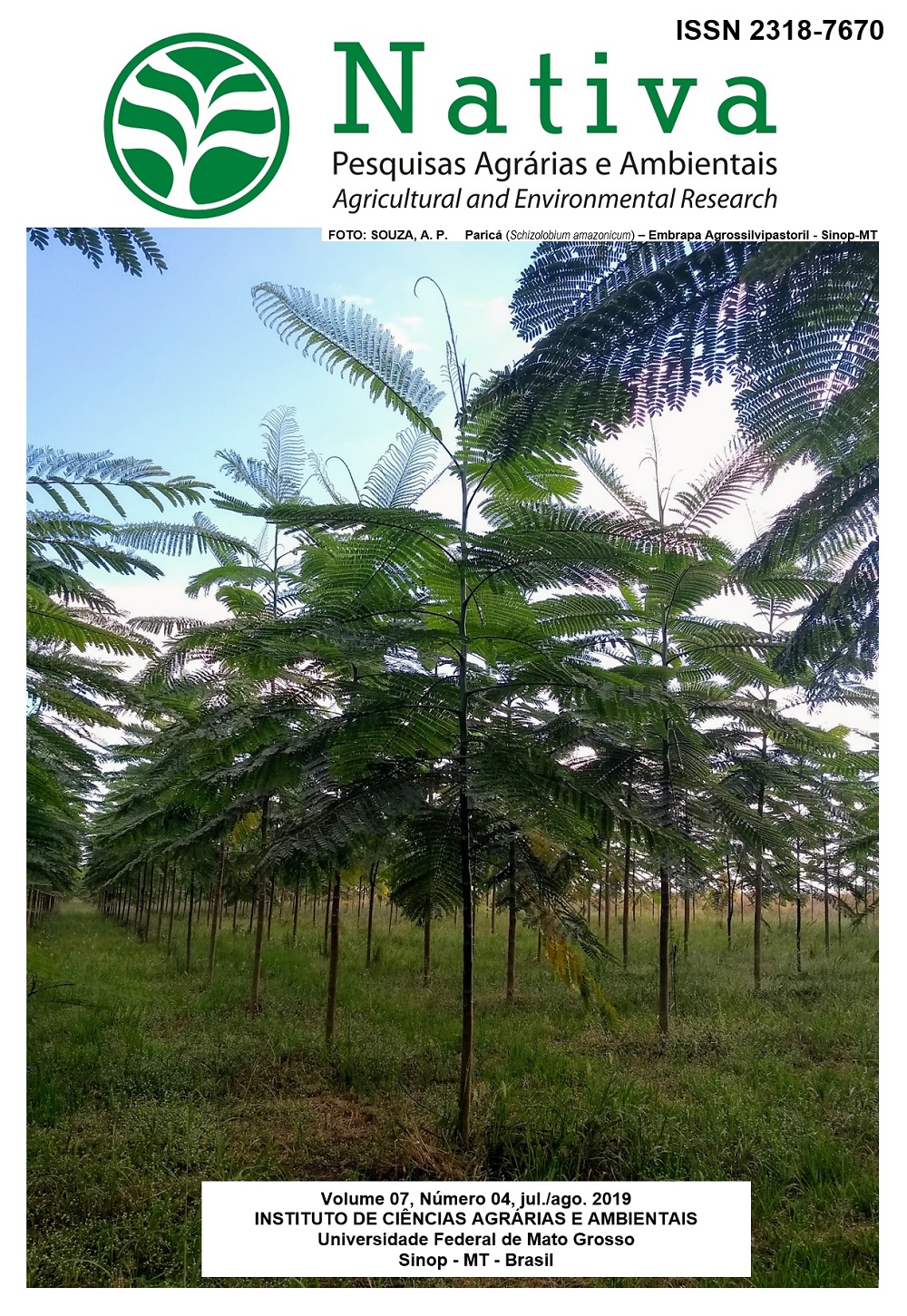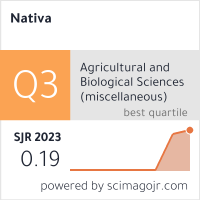CONTROL OF MAHOGANY SHOOT BORER, Hypsipyla grandella (Lepidoptera: Pyralidae), WITH Bacillus thuringiensis IN A SYSTEMIC WAY
DOI:
https://doi.org/10.31413/nativa.v7i4.6567Resumo
CONTROLE DA BROCA-DO-MOGNO, Hypsipyla grandella (Lepidoptera: Pyralidae), COM O USO SISTÊMICO DE Bacillus thuringiensis
Hypsipyla grandella (Lepidoptera: Pyralidae), conhecida popularmente como broca-do-mogno, é a principal praga de Swietenia macrophylla (Meliaceae), limitando o plantio comercial da espécie no Brasil. O uso da bactéria Bacillus thuringiensis (Bt) para o controle de insetos pode se tornar promissor para ser incorporado em programas de manejo integrado de pragas de várias pragas agrícolas e florestais. Não há, atualmente, estudos com o uso de Bt para controlar H. grandella de forma sistêmica. Assim, esse estudo teve como objetivo avaliar o uso sistêmico de Bt em mudas de mogno para o controle do inseto. Os resultados demonstraram que as plantas tratadas com a estirpe S1905 mostraram um ataque desacelerado quando comparado com o controle, com poucos danos e sintomas. Esse trabalho é pioneiro no uso sistêmico de Bt em mudas de espécies florestais e esse método pode ser uma alternativa viável e promissora ao uso de inseticidas químicos.
Palavras-chave: endofítico, toxinas cry, praga florestal, entomologia florestal, controle biológico.
ABSTRACT:
Hypsipyla grandella (Lepidoptera: Pyralidae), popularly known as the mahogany borer, is the main pest of Swietenia macrophylla (Meliaceae), limiting the commercial planting of the species throughout Brazil. The use of the Bacillus thuringiensis (Bt) bacterium for the control of insect pests is becoming a promising tool to be incorporated into integrated pest management programs for various agricultural and forest pests. To date, no in-depth studies on the use of Bt for control of H. grandella have been conducted. Therefore, this study aimed to evaluate the systemic use of Bt in mahogany seedlings for insect control. The results demonstrated that plants treated with the S1905 strain showed a decelerated attack compared with the control, with little apparent damage or symptoms. This work is an early effort in the systemic use of Bt in seedlings of tree species and the method seems to offer a promising and viable alternative to the use of chemical insecticides.
Keywords: endophytic, cry toxins, forest pest, forest entomology, biological control.
Referências
ABBOT, W. S. A method of computing the effectiveness of an insecticide. Journal of Economic Entomology, Lanham, v. 18, n. 2, p. 265-266, 1925. DOI: https://dx.doi.org/10.1093/jee/18.2.265a
BAUM, J. A.; JOHNSON, T. B.; CARLTON, B. C. Bacillus thuringiensis. Natural and recombinant bioinsecticide products. Methods Biotechnology, v. 5, p. 189–209, 1999. DOI: https:// dx.doi.org/10.1385/0-89603-515-8:189
BIZARRI, M. F.; BISHOP, A. H. Recovery of Bacillus thuringiensis in vegetative form from phylloplane of clover (Trifolium hybrindum) during a growing season. Journal of Invertebrate Pathology, San Diego, v. 94, n. 1, p. 38-47, 2007. DOI: https://dx.doi.org/10.1016/j.jip.2006.08.007
CABI_COMMONWEALTH AGRICULTURAL BUREAU INTERNATIONAL. Forestry Compendium. CD Version. Wallingford, UK: CAB International, 2005.
CASTRO, M. T.; MONTALVÃO, S. C. L.; MONNERAT, R. G. Breeding and biology of Hypsipyla grandella Zeller (Lepidoptera: Pyralidae) fed with mahogany seeds (Swietenia macrophylla King). Journal of Asia-Pacific Entomology, v. 19, n. 1, p. 217-221, 2016. DOI: https:// dx.doi.org/10.1016/j.aspen.2016.01.008
CASTRO, M. T.; MONTALVÃO, S. C. L.; MONNERAT, R. G. Ocorrência e patogenicidade de Beauveria bassiana à Hypsipyla grandella coletada em Brasília. Nativa, Sinop, v. 5, n. 4, p. 263-266, 2017. DOI: http://dx.doi.org/10.5935/2318-7670.v05n04a06
CASTRO, M. T.; MONTALVÃO, S. C. L.; MONNERAT, R. G. Damage in fruits of mahogany caused by Hypsipyla grandella (Zeller) (Lepidoptera: Pyralidae) in Brasília, Brazil. EntomoBrasilis, Vassouras, v. 11, n. 1, p. 9-12, 2018a. DOI: http://dx.doi.org/10.12741/ebrasilis.v11i1.690
CASTRO, M. T.; MONTALVÃO, S. C. L.; MONNERAT, R. G. Susceptibility of Hypsipyla grandella (Lepidoptera: Pyralidae) to Bacillus thuringiensis strains. Journal of Plant Protection Research, v. 58, n. 1, p. 102-105, 2018b. DOI: http://dx.doi.org/10.24425/119121
CARVALHO, P. E. R. Mogno – Swietenia macrophylla. Colombo-PR, Embrapa Florestas, 2007. 12 p. (Circular Técnica, 140).
COÊLHO, M. M.; FERREIRA-NOZAWA, M. S.; NOZAWA, S. R.; SANTOS, A. L. W. Isolation of endophytic bacteria from arboreal species of the Amazon and identification by sequencing of the 16S rRNA enconding gene. Genetics and Molecular Biology, São Paulo, v. 34, n. 4, p. 676-680, 2011. DOI: http://dx.doi.org/10.1590/S1415-47572011005000045
COSSALTER, C.; NAIR, K. S. S. The state of the forest and plantation trends. In: NAIR, K. S. S. (Ed.). Insect pests and diseases in Indoneasian forests: An assessment of the major threats, research efforts and literature. Indonesia: Center for International Forestry Research, 2000. p. 3-9.
DAVITT, A. J.; CHEN, C.; RUDGERS, J. A. Understanding context-dependency in plant-microbe symbiosis: the influence of abiotic and biotic contexts on host fitness and the rate of symbiont transmission. Environmental and Experimental Botany, Elmsford, v. 71, p. 137-145, 2011. DOI: https://doi.org/10.1016/j.envexpbot.2010.11.004
GRIJPMA, P. Resistance of Meliaceae against the shoot borer Hypsipyla with particular reference to Toona ciliata M. J. Roem. var. australis (F.v. Muell.) CDC. In: BURLEY, J.; STYLES, B.T. (Ed.). Tropical trees: variation breeding and conservation. London: Linnaean Society, 1976. p. 69-78.
GRIFFITHS, M. W. The biology and host relations of the red cedar tip moth, Hypsipyla robusta, .in Australia. In: SNELL, A.; VIZE, S. (Ed.) Opportunities for the New Millennium: Proceedings of the Australian Forest Growers Biennal Conference. Canberra: Australian Forest Growers, 2000. p. 135-140.
HARDOIN, P. R.; VAN OVERBEEK, L. S.; Van ELSAS, J. D. Properties of bacterial endophytes and their proposed role in plant growth. Trends Microbiology, v. 16, n. 10, p. 463-471, 2008. DOI: https://dx.doi.org/10.1016/j.tim.2008.07.008
HINTON, D. M.; BACON, C. W. Enterobacter cloacae is an endophytic symbiont of corn. Mycopathologia, Den Haag, v. 129, n. 2, p. 117-125, 1995. DOI: https://dx.doi.org/10.1007/BF01103471
KAMATH, M. K.; SENIVASA, E.; BOLA, I. 1996. Impact of termites on mahogany (Swietenia macrophylla) plantations in Fiji, In: NAIR, K. S. S. Impact of Diseases and Insect Pests in Tropical Forests. Peechi, India: Kerala Forest Research Institute, 1996. p. 298-303.
LUNZ, A. M.; THOMAZINI, M. J.; MORAES, M. C. B.; NEVES, E. J. M.; BATISTA, T. F. C.; DEGENHARDT, J.; SOUSA, L. A.; OHASHI, O. S. Hypsipyla grandella em Mogno (Swietenia macrophylla): situação atual e perspectivas. Pesquisa Florestal Brasileira, Colombo, n. 59, p. 45-55, 2009. DOI: http://dx.doi.org/10.4336/2009.pfb.59.45
MADUELL, P.; ARMENGOL, G.; LIAGOSTERA, M.; LINDOW, S.; ORDUZ, S. Immigration of Bacillus thuringiensis to bean leaves from soil inoculums or distal plant parts. Journal of Applied Microbiology, Oxford, v. 103, n. 6, p. 2593-2600, 2007. DOI: https://dx.doi.org/10.1111/j.1365-2672.2007.03509.x
MAHROOF, R. M.; HAUXWELL, C.; EDIRISINGHE, J. P.; WATT, A. D.; NEWTON, A. C. Effects of artificial shade on attack by the mahogany shoot borer, Hypsipyla robusta (Moore). Agricultural and Forest Entomology, Midlothian, v. 4, n. 4, p. 283-292, 2002. DOI: https://dx.doi.org/10.1046/j.1461-9563.2002.00146.x.
MONNERAT, R. G.; SANTOS, R.; BARROS, P.; BATISTA, A.; BERRY, C. Isolamento e caracterização de estirpes de Bacillus thuringiensis endofíticas de algodão. Brasília: Embrapa Recursos Genéticos e Biotecnologia, 2003. 4 p. (Comunicado Técnico, 98).
MONNERAT, R. G.; BATISTA, A. C.; MEDEIROS, P. T.; MARTINS, E.; MELATTI, L. V.; PRAÇA, L.; DUMAS, V.; DEMO, C.; GOMES, A. C.; FALCÃO, R.; BERRY, C. Characterization of Brazilian Bacilus thuringiensis strains active against Spodoptera frugiperda, Plutella xylostella and Anticarsia gemmatalis. Biological Control, Orlando, v. 41, n. 3, p. 291– 295, 2007. DOI: https://dx.doi.org/10.1016/j.biocontrol.2006.11.008
MONNERAT, R. G.; SOARES, C. M. S.; GOMES, A. C. M.; JONES, G.; MARTINS, E.; PRAÇA, L. B.; BERRY, C. Translocation and insecticidal activity of Bacillus thuringiensis bacteria living inside of plants. Microbial Biotechnology, v. 2, n. 4, p. 1560-1562, 2009. DOI: https://doi.org/10.1111/j.1751-7915.2009.00116.x
OHASHI, O. S.; COSTA, M. S. S.; SILVA, J. N. M.; SILVA, M. F. G. G. Resistência do tipo antibiose apresentada pelas folhas novas de Toona ciliata M. J. Roem às lagartas de Hypsipyla grandella Zeller. Belém, Embrapa Amazônia Oriental, 2000. 3 p. (Comunicado Técnico, 48).
OHASHI, S. T.; SILVA, J. N. M.; SILVA, M. E. C. E.; COSTA, M. S. S.; SARMENTO JUNIOR, R. G.; SANTOS, E. B.; ALVES, M. Z. N.; PESSOA, A. M. C.; SILVA, T. C. O.; BITTENCOURT, P. R. G.; BARBOSA, T. C.; SANTOS, T. M. Manejo Integrado da Broca do Mogno Hypsipyla grandella Zeller (Lep. Pyralidae). In: POLTRONIERI, L. S.; TRINDADE, D. R. Manejo integrado das principais pragas e doenças de cultivos amazônicos. Belém: Embrapa Amazônia Oriental, 2002. 304 p.
OHASHI, O. S.; SILVA JUNIOR, M. L.; LAMEIRA, O. A.; SILVA, J. N. M.; LEÃO, N. V. M.; TEREZO, E. F.; BATISTA, T. F. C.; HIDAKA, D. Z. L.; ALMEIDA, G. B.; BITTENCOURT, P. R. G.; GOMES, F. S.; NEVES, G. A. M. Danos e controle da broca de Hypsipyla grandella em plantio de mogno no Estado do Pará. In: POLTRONIERI, L. S.; TRINDADE, D. R.; SANTOS, I. P. Pragas e doenças de cultivos Amazônicos. Belém, Embrapa Amazônia Oriental, 2005. 483 p.
PANDEY, D. Growth and yield of plantation species in the tropics. Rome: FAO (W/R 0867). 1983.
PANDEY, D. Hardwood plantations in the tropics and subtropics: Tropical forest plantation areas 1995, Project GCP/INT/628/UK. Rome: FAO, 1997.
PRAÇA, L. B.; GOMES, A. C. M. M.; CABRAL, G.; MARTINS, E. S.; SUJII, E. H.; MONNERAT, R. G. Entophytic colonization by brazilian strains of Bacillus thuringiensis on cabbage seedlings grown in vitro. Bt Research, v. 3, n. 3, p. 11-19, 2012. DOI: https://dx.doi.org/10.5376/bt.2012.03.0003
SILVA, N. M. Características biológicas e demográficas de Hypsipyla grandella (Zeller, 1848) (Pyralidae, Lepidoptera) e níveis de infestação sob dois sistemas de plantio de Carapa guianensis Aubl. (Meliaceae) no Amazonas. 1985. 103f. Dissertação (Mestrado em Ciências Biológicas) – Departamento de Ciências Fundamentais e Desenvolvimento Agrícola, Instituto Nacional de Pesquisas da Amazônia, Manaus, 1985.
SILVA JÚNIOR, M. L.; SOUZA JÚNIOR, J. C.; BRAGA, A. C. M.; OHASHI, O. S.; MELO, V. S.; SILVA, G. R.; PEDROSO, A. J. S.; VIÉGAS, I. J. M.; SALDANHA, E. C. M. Crescimento de mogno-brasileiro e resistência a Hypsipyla grandella em função do cálcio e do boro. Revista Árvore, Viçosa, v. 38, n. 6, p. 1085-1094, 2014. DOI: http://dx.doi.org/10.1590/S0100-67622014000600013
ULRICH, K.; ULRICH, A.; EDWALD, D. Diversity of endophytic bacterial communities in poplar grown under field conditions. FEMS Microbiology Ecology, Amsterdam, v. 63, n. 2, p. 169-180, 2008. DOI: http://dx.doi.org/10.1111/j.1574-6941.2007.00419.x
VERGARA, B. J. A. Aproximación hacia un manejo integrado del barrenador de las Meliacea, Hypsipyla grandella Zeller. Revista Forestal Venezoelana, v. 41, n. 1, p. 23-28, 1997.
WHITELEY, H. R.; SCHNEPF, H. E. The molecular biology of parasporal crystal body formation in Bacillus thuringiensis. Annual Review of Microbiology, Palo Alto, v. 40, p. 549-576, 1986. DOI: https://dx.doi.org/10.1146/annurev.mi.40.100186.003001
WYLIE, F. R. Control of Hypsipyla spp. shoot borers with chemical pesticides: a review. In: FLOYD, R. B.; HAUXWELL, C. (Ed.) Hypsipyla Shoot Borers in Meliaceae: Proceedings of an International Workshop. Canberra: Australian Centre for International Agricultural Research, 2001. p. 109-117.
Downloads
Publicado
Edição
Seção
Como Citar
Licença
Direitos Autorais para artigos publicados nesta revista são do autor, com direitos de primeira publicação para a revista. Em virtude de a aparecerem nesta revista de acesso público, os artigos são de uso gratuito, com atribuições próprias, em aplicações educacionais e não-comerciais.
A artigos publicados nessa revista, podem ser reproduzidos parcialmente ou utilizados como referência por outros autores, desde que seja cita a fonte, ou seja, a Revista Nativa.
Copyright for articles published in this journal are the authors, with first publication rights granted to the journal. The journal shows open access, and articles are free to use, with proper attribution, in educational and non-commercial.
The articles published in this journal may be reproduced in part or used as a reference by other authors, provided that the source is quoted.






